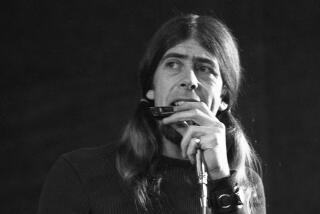The Steel-Bonded, Shimmery Sound of Ahmad Jamal
- Share via
At times during pianist Ahmad Jamal’s concert, the steel drums of Othello Molineaux seemed an extension of Jamal’s piano. Indeed, the measured flow between the two instruments, despite their disparate sounds, sometimes seemed to come from a single musician Saturday night at Orange Coast College in Costa Mesa.
While the configuration of a quartet with piano, steel drum, bass and drums is unusual in jazz, Jamal and Molineaux made it sound like the most natural thing in the world in the Robert B. Moore Theatre. The two men often shared the lead, playing in unison. Other times, they alternated, with piano taking a line here, steel drum taking a line there. Jamal used harmonically dense chords to back Molineaux. The steel drummer created shimmering, two-note blends to support the piano.
Jamal frequently has said he thinks in orchestral terms, and even when playing solo, his sound was thick and sweet as cream. The steel drums, with their ringing, metallic tones, deepened this effect. And, as has been the practice through some four decades, Jamal’s bass and drums accompaniment, here supplied by upright player James Cammack and percussionist Frank Gant, extended the orchestral support, not just with timekeeping but with sounds and counterpoints that dressed out the quartet.
Jamal, as he has done since the 1950s, took heavy liberties with the songs he played, whether standards or his originals. The rendition of his best-known “Poinciana,” played without steel drums, was sharper and more assertive than that heard on his groundbreaking “Live at the Pershing” recording of 1958, and any of its several made thereafter.
Jamal played a medley associated with Duke Ellington, including “Take the A-Train” and “C-Jam Blues,” over bassist Cammack’s repeated refrain from “Do Nothin’ Till You Hear From Me.” Even his presentation of “End of a Love Affair” was much different from the one heard on his just-released recording “Nature.”
These sparks of creative improvisation, long a Jamal trademark, were evident throughout the show as the pianist inserted twists and turns, signaling his sidemen with hands, nods from his head and his play. That his three bandmates were able to follow these impromptu whims spoke to their long relationship with the bandleader.
*
Though Jamal is known for his use of space--in other words, silence--his play was more extended this night. Trills, echoes and other muscular embellishments filled the simplest lines. When he did leave provocative empty moments, Molineaux was often there to fill them in.
Jamal’s technical abilities were matched by Molineaux’s on steel drum. Playing the instrument with two short “pan” sticks that he sometimes clapped together for percussive effect, Molineaux’s lines came in bursts, seeming to accelerate as they progressed. His play in lightning unison with the piano was especially impressive.
Despite the unusual instrumentation of the quartet, Jamal’s attractions remained much as they have been since the ‘50s. A strong rhythmic slant kept even the most detailed music accessible. Jamal’s smart sense of narrative gave his every solo the feel of a well-edited movie. Beautiful, sometimes uneasy harmonic blends gave the pieces a sense of depth seemingly generated from more than four players.
The concert, which received enthusiastic ovations throughout the evening from the nearly 400 people in attendance, left one inescapable conclusion: Few pianists are as individually expressive as Ahmad Jamal.
More to Read
The biggest entertainment stories
Get our big stories about Hollywood, film, television, music, arts, culture and more right in your inbox as soon as they publish.
You may occasionally receive promotional content from the Los Angeles Times.










